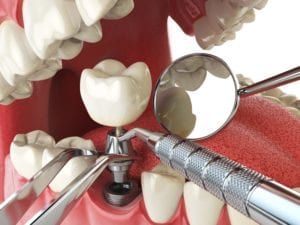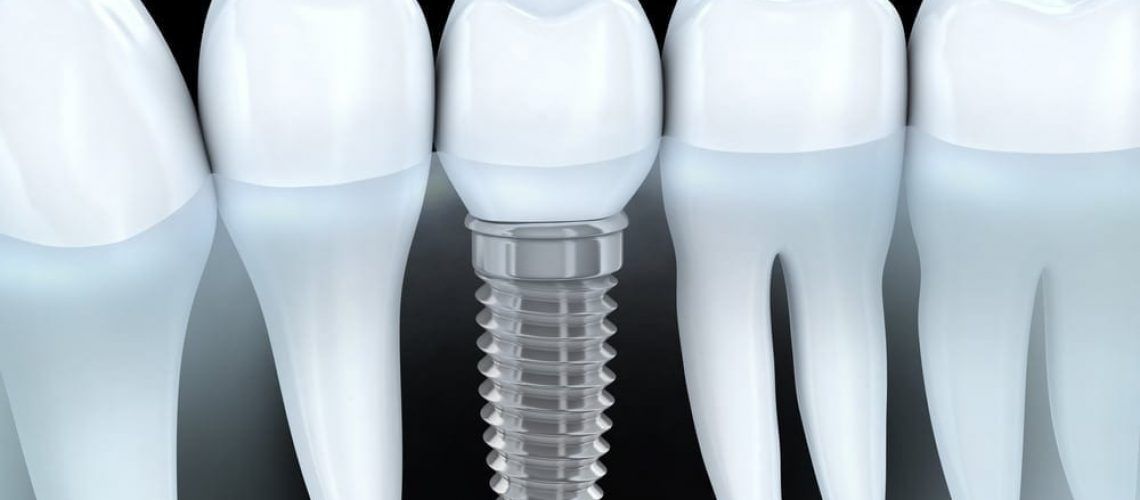Dental implants are dental restorations composed of a titanium screw, metal connector, and dental prosthesis. The implant screw is implanted into the jawbone and acts as an artificial tooth root. Once it fuses with the surrounding bone, it becomes strong enough to support various dental prostheses such as crowns, bridges, or dentures. The metal connector joins the implant screw to the dental prosthesis and can vary in composition depending upon the type of dental prosthesis used. Dental implants can be used to replace a single missing tooth or for an entire smile makeover. Additionally, they can also be used to replace teeth that are severely decayed or damaged.
There are two different types of dental implants:
- Endosteal: uses an implant screw that sits inside the jawbone for supporting a dental prosthesis. This is the most common type of dental implant and is available in three sizes:
-
- Standard Size: the traditional size of a dental implant and is most commonly used.
- Wide Size: larger circumference than a standard size and used for extra support in molars.
- Mini Dental Implants: smaller circumference than a standard size and used for tight spaces of low bone mass.
- Subperiosteal: uses a metal framework that sits on top of the jawbone for supporting a dental prosthesis. This type of dental implant is not as common and is rarely used due to its lack of strength compared to the endosteal implant.
Did You Know?
Dental Implants are an extremely popular restoration option for replacing missing teeth. Currently, The American Academy of Implant Dentistry notes that 3 million Americans have dental implants. They also estimate that 500,000 people get dental implants each year.
Frequently Asked Questions:
Am I a candidate for dental implants?
You may be a candidate for dental implants if you currently have one or more missing teeth, or if you have teeth that are in need of extraction because of severe decay or damage. Additionally, dental implants require adequate bone mass for safe placement. To determine if you have adequate bone mass, your Saratoga implant dentist will perform dental x-rays. In cases where bone loss has occurred, a bone graft may be required for the placement of dental implants. Ultimately, only a consultation with an experienced implant dentist can determine if you are an ideal candidate for dental implants.
What can I expect when having dental implant treatment at my Saratoga dentist?

Dental implant treatment begins with the placement of dental implants, which requires a minor oral surgery. During implant placement surgery, a tiny incision is made in the gums. This allows your Saratoga implant dentist to reach the jawbone so that it can be properly prepared and shaped for an implant screw. Once the implant screw is in place, the connector piece will be attached. Finally, the gums will be sutured around the metal connector so that it sticks out of the gums.
At this point, a temporary or permanent restoration is usually placed on the connector. In cases where a temporary is placed, a second appointment is required to place the permanent restoration. In other cases, no restoration may be placed until this second appointment.
What can I expect when recovering from dental implant treatment?
When recovery from dental implants, you can expect your Saratoga implant dentist to provide you with detailed post-treatment instructions. It is highly important that you follow all these instructions for the best possible outcome. In most cases, these can include keeping the treatment site clean, eat a temporary soft foods diet, and avoiding detrimental behaviors like smoking, teeth grinding, or using your teeth to open packages.
Following these instructions is an essential part of recovering from implant surgery because it takes about 3-6 months for your implant to fuse with the surrounding bone. Once fused with the surrounding bone, your implant is considered successful.

